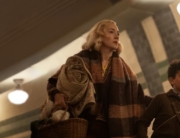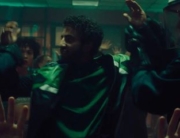As the son of Turkish immigrants to Germany, writer/director Fatih Akin specifically cites Istanbul-born Elia Kazan’s America America (1963), with its bitter scenes of the Turks’ oppressive treatment of minorities during the end of Ottoman control, as inspiring him to more fully portray the devastation of the Armenian people during World War I.
The Cut is in the cinematic tradition of sweeping epics centering on stoic immigrants to the New World who stayed silent about what pushed them out of the old country: the Swedes in Jan Troell’s The Emigrants (1971), the Italians in Francis Ford Coppola’s The Godfather Part II (1974), and the Irish in Ron Howard’s Far and Away (1992). This stunning-looking portrait of a wandering diaspora of traumatized survivors, through the Middle East and to the shores and heartland of North America, has some startlingly fresh images amid a few familiar echoes, while bringing up striking comparisons to contemporary issues.
It opens in 1915 in the Old City of Mardin, in southeastern Turkey near the Syrian border, where skilled Armenian blacksmith Nazaret Manoogian (Tahar Rahim) lives surrounded by his extended family. He’s so devoted to his young twin daughters, Arsinée and Lucinée, that he takes them to and from school (in a bit of a dig at the mosques around them for not educating girls). Rumors of Turkish soldiers rounding up Armenian men are reported from ever closer towns, but the community seems sure the usual bribes will protect them. Nazaret is reassured by his wife’s lullaby, a tune that will be a repeated reminder of her throughout his ordeal.
When gendarmes rouse the family in the middle of the night, their excuse is conscription for the war to build a road, and Armenian men are marched off to an area of stony desolation. But the starved and brutal conditions soon belie their hopes that their productivity can protect them. Worse, newcomers whisper that families back home in all their towns have been forcibly removed—incomprehensible to them until a woeful line of women and children staggers past them. Nazaret tries to help a young fainting woman, but is beaten back by the soldiers, and he can only surreptitiously revive his weakened brother.
In 1916, the governor’s emissary brings new orders to offer the exhausted men a pardon, and apricots, if they convert to Islam from Christianity. Some accept, to heckling from Nazaret and others. The weakened Armenians are rounded up and chained by a mocking, motley troop and forced into a death march. The complicated story avoids attribution of direct government involvement in the massacre and even inserts a helpful Turk for balance amid the murderous frenzy unleashed against the Armenians.
The multilingual Rahim’s expressive talents come to the fore throughout a long, tragic odyssey of more than a few coincidences that veers toward Candide in order for Akin to cram his substantial research into one man’s fate. Falling in with a roaming band of bandits, Nazaret recognizes the driver of a fleeing wagon as one of his former clients, who reveals the awful news of where the women and children were sent. Desert hallucinations of his wife and her song lead Nazaret to a seemingly generous Bedouin family who provide refreshment and brief respite.
A bombardment of images resonates from Holocaust films. When Nazaret finds the huge, horrific encampment of Armenian families, it’s a shocking visual set piece of dying babies, children, and the elderly wasting away in the desert sun and heat. As he holds his sister-in-law in time for her last gasps, she describes the rest of the family’s deaths, and she hints at the survival of his daughters. Escaping on, and then thrown off, a train, he is rescued by a kindly Syrian Muslim merchant, Omar Nasreddin (Makram J. Khoury), who soon fills his soap factory with the bedraggled remnant from the genocide. Nazaret hides out until 1918 when the defeated Turks are jeered through the streets of Aleppo (like postwar scenes of taunted Nazi collaborators) and the factory becomes a center for forlorn survivors sharing any scrap of information about their missing loved ones.
By 1921, a rumor of a new form of magic shakes the shell-shocked refugees, with passionate arguments whether it’s for good or ill: Nazaret is pushed along in the curious crowd and looks up and discovers Charlie Chaplin’s silent film The Kid projected on a wall, which gives him and others the gifts of catharsis and laughter (heavy borrowing from Preston Sturges’s 1941 Sullivan’s Travels).
Grim, aging Nazaret follows tantalizing clues to his daughters, from bordellos to orphanages, through the wide dispersal of the buffeted Armenians as they resist assimilation to reestablish their shattered communities, across the ocean in the tropical heat of Cuba (filmed in Havana and featuring Armenian-Canadian actress Arsinée Khanjian in a brief role) to the snowy northern plains of the United States. After what he’s already faced, Nazaret doesn’t let the immigration restrictions of 1924 and the accompanying anti-immigrant violence stop him. The sense of how a persecuted people from a destroyed homeland form an ethnic conclave with psychological baggage was probably informed by co-writer Mardik Martin, Martin Scorsese’s collaborator on such classics as Mean Streets (1973) and Raging Bull (1980). The central character is named in honor of New York University professor Haig Manoogian.
Akin claims The Cut is the finale of his “Love, Death and the Devil” trilogy, after Head-On (2004) and The Edge of Heaven (2007). That theme gets lost in the beautiful imagery, inspired by the look of Terrence Malick’s Days of Heaven (1978) and shot by Akin’s frequent cinematographer Rainer Klausmann on 35mm film with wide-angle lenses. The powerful travelogue visuals almost overwhelm the enormity of the Armenian genocide and the cross-continental diaspora.







Leave A Comment